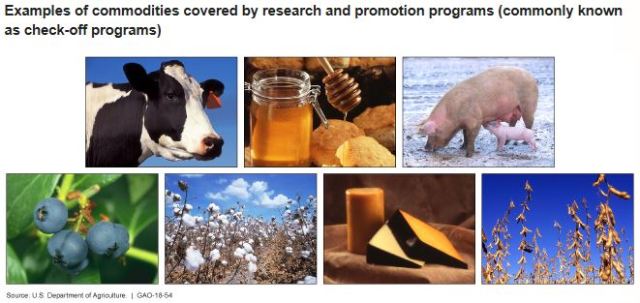Did you picture yourself with a milk mustache after seeing those “Got Milk?” ads? Or pick up some ribs at the supermarket with the thought that you were buying “Pork: The Other White Meat”?
These memorable catchphrases from advertising campaigns were used by some of the 22 federal agricultural research and promotion programs, more commonly known as “check-off” programs. Producers of agricultural commodities—such as dairy, eggs, and beef—fund these efforts.
Today’s WatchBlog explores
our recent report on these check-off programs and their federal oversight.
Check-off programs: they’re what’s under review
The name “check-off” comes from a time when producers checked off a box on a form indicating their willingness to participate in the program, according to the National Agricultural Law Center. While the programs are now mandatory, the name stuck around.
Authorized by Congress or USDA, each check-off program is led by a board composed of industry representatives. While programs differ, each exists to expand the market for a commodity through promotion, research, and consumer and industry information. USDA’s Agricultural Marketing Service oversees their work.
Programs do not receive federal appropriations. Instead, producers, handlers, processors, importers, or others fund the programs through assessments for each unit of the commodity sold, produced, or imported. The boards use this money to fund program efforts and to reimburse AMS for its oversight costs.
 Milk, honey, pork, blueberries, cotton, dairy, and soybeans are some commodities covered by check-off programs.
Milk, honey, pork, blueberries, cotton, dairy, and soybeans are some commodities covered by check-off programs.
To oversee programs, AMS follows a set of guidelines that provide broad information on its expectations for board operations and on oversight of program activities (such as budget approval, contracts, and financial accountability). In 2012, USDA’s Office of Inspector General made two recommendations to AMS to improve its oversight of the check-off programs. In response to one of those recommendations, AMS developed standard operating procedures, which outline specific AMS oversight responsibilities.
Subcontracts and transparency
We looked at a sample of eight check-off programs and found that AMS doesn’t provide consistent oversight in certain areas. For example, some programs use subcontractors and, under current guidelines, AMS staff must review a sample of subcontracts. We found that AMS reviewed subcontracts for only one of the eight programs we studied. Although that is not inconsistent with current operating procedures, more review of subcontractors could improve AMS’s ability to prevent misuse of funds.
We also found that only four of the eight programs posted on their websites all the key documents that could help create greater transparency. They all posted budget summaries, as required, but half of them lacked more detailed budget information or evaluations of how effective their outreach efforts have been—currently optional, but useful for people interested in program operations.
We made five recommendations, among them that:
- AMS consistently reviews subcontracts to prevent misuse of funds, and
- AMS ensures documents are on program websites to promote transparency and ensure stakeholders have access to information on program operations.
Check out our report to learn more about all
five recommendations. A related recent report also delves into the
status of FOIA requests for this program.
Questions on the content of this post? Contact Steve Morris at
morriss@gao.gov.
Comments on GAO’s WatchBlog? Contact
blog@gao.gov.
 Milk, honey, pork, blueberries, cotton, dairy, and soybeans are some commodities covered by check-off programs.
Milk, honey, pork, blueberries, cotton, dairy, and soybeans are some commodities covered by check-off programs.
